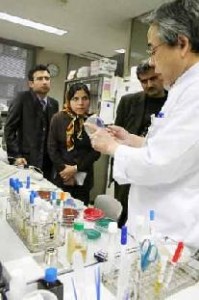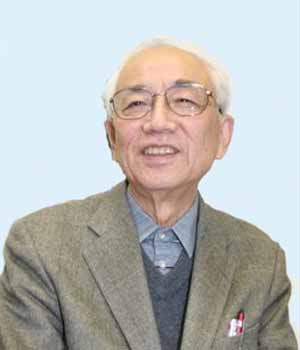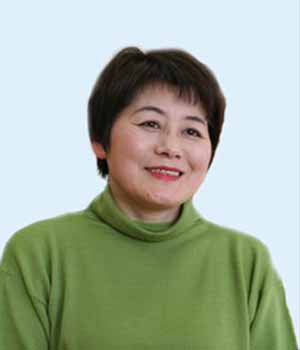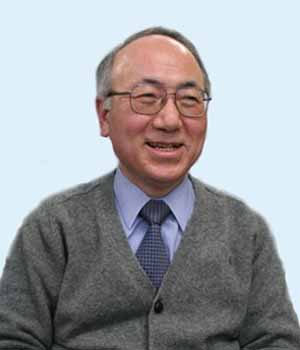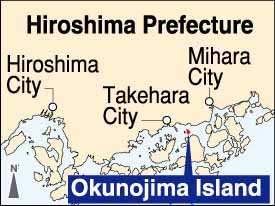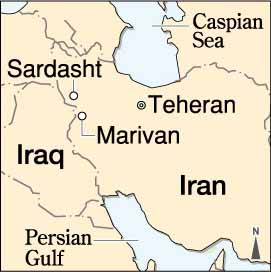Support for sufferers of poison gas, from Hiroshima to Iran
Feb. 21, 2008
by Miho Kuwajima, Staff Writer
It has been twenty years since the end of the Iran-Iraq War, which took place from 1980-1988. The government of Iran reports that approximately 50,000 people are still suffering from the aftereffects of poison gas used during this conflict. Against the backdrop of Iran’s international isolation due to its suspected nuclear weapons program, a group of three Iranian doctors and one nurse came to Hiroshima in mid-January to take part in a three-week training program. With Hiroshima’s experiences of rising above the ruin of the atomic bombing, and of providing medical care to sufferers of a poison gas factory that was in operation during World War II, support for the people of Iran is now readily offered.
The Kure Kyosai Hospital is located in the town of Tadanoumi in Hiroshima Prefecture, on the shore opposite Ohkunoshima Island, where a poison gas factory once stood. This hospital was the first stop for the team of four from Iran. Inside are approximately 4,200 medical charts that detail case histories, treatment, and causes of death for patients linked to the poison gas factory.
Masato Yukutake, 73, is the former director of the hospital and he now works at the facility as a medical examiner. Dr. Yukutake has been providing medical care to victims of poison gas since he first arrived at the hospital in 1962.
In June 2005, Dr. Yukutake made his first visit to Iran with Shizuko Tsuya, 52, a pharmacist and the president of a Hiroshima-based NPO called “Moct,” which delivers medical provisions to areas of conflict. Guided by local NGOs in Iran, they spent time at villages which had been attacked by the Iraqi military with poisonous mustard gas.
At every stop, village heads welcomed the group of visitors warmly and poison gas sufferers and their families crowded around the Japanese members. The health clinics in these villages, though, were like shacks and some had no doctors or medical equipment.
Dr. Yukutake felt that “poison gas victims in Iran have been abandoned.” Some coughed up pus-like phlegm while others had difficulty breathing. The scenes he witnessed in Iran reminded him of the patients he has seen in Japan over the past 40 years.
In Iran, which suffered chemical weapon attacks by Iraqi forces roughly 300 times, sufferers of poison gas are scattered around the nation and the country has yet to grasp the true extent of the problem.
At the Kure Kyosai Hospital, Dr. Yukutake explained the methodology of medical examinations and the causes of death of poison gas patients. Dr. Mohammad Mirhashemi, 46, remarked, “The findings from Ohkunoshima Island are very informative. This experience reaffirms for me the importance of exchange among doctors and scientists.”
The training program was conceived by Yasuteru Inai, 59, who serves as the head of the Department of Pathology at Hiroshima University Graduate School of Biomedical Sciences. His department has conducted pathological studies on the Ohkunoshima poison gas sufferers for the past 50 years.
Dr. Inai asked the Hiroshima Prefectural Hospital and Yoshijima Hospital, also located in Hiroshima, for their participation in this project as both hospitals have medical expertise on respiratory ailments, which are often seen in victims of poison gas. At the Radiation Effects Research Foundation in Hiroshima, Professor Inai arranged for the Iranian team to study intake methods that can enable doctors to record the patient’s condition with more objectivity through calculations involving the level of exposure. In Iran, patients have apparently been divided into three general categories in a rough attempt to ascertain their conditions, namely “serious,” “moderate,” and “mild.”
Farahnaz Falahati, 32, a female doctor at the Janbazan Medical & Engineering Research Center, commented, “I became aware of hospital systems, examination methods, treatment options, and other useful ideas. The entire training has been beneficial.” Dr. Falahati has discussed a collaboration with doctors at the Department of Pathology at Hiroshima University which will involve the sharing of data from each side.
“In the beginning, I was a bit overwhelmed,” Dr. Inai said, looking back on his visit to Iran in June 2006 when he accompanied members of “Moct” at their request.
In addition to visiting hospitals, their itinerary included courtesy calls on the mayor of Teheran and the Vice-President of Iran. At nearly every stop, about 20 reporters awaited the Japanese party and posed the same question: “What do you think about the United States dropping the atomic bombs on Hiroshima and Nagasaki?”
Dr. Inai expressed his purpose in visiting Iran by replying, “We didn’t come here out of any animosity towards the United States. War itself brings such tragedies. As a doctor, my aim is to build solidarity with the Iranian people through relief efforts for the sufferers of poison gas.” Prior to returning to Japan, Dr. Inai exchanged a memorandum for medical exchange and research with the Janbazan Medical & Engineering Research Center.
One-and-a-half years have passed since the signing of this memorandum. In regard to receiving an Iranian delegation for training in Hiroshima, media reports of Iran’s nuclear development apparently prompted concern from some quarters. In addition, changing requests from the Iranian side--including the provision of medical equipment--seemed to make the project more difficult to implement.
However, Ms. Tsuya stressed that “Hiroshima understands the importance of embracing hope over ill will as well as overcoming the negative legacy of its own experience with poison gas. Supporting other sufferers of poison gas through this medical exchange is Hiroshima’s obligation.”
Ms. Tsuya first encountered the sufferers of poison gas in Iran when she took part in the Hiroshima World Peace Mission in April 2004. Since then, she has visited a number of areas afflicted by poison gas attacks and invited victims to the Peace Memorial Ceremony in Hiroshima on August 6 each year. By doing so, she hopes to “return the affection that Hiroshima received from the world in the process of reconstructing the city from the ashes of the atomic bombing.”
Suleiman Ghaderi, 26, a nurse in the group from Iran, is from Sardasht, a city whose inhabitants suffered mustard gas attacks up to seven times a day. He lost an older brother due to this poison gas. Mr. Ghaderi said, smiling, “I was encouraged by the people of Hiroshima who are mindful of the horror of war while striving for peace.”
Dr. Mirhashemi, who has been involved in creating a program for medical examinations, explained, “In Iran, the patients are mainly in their 30s and 40s. They not only face challenges to their physical health, they suffer from problems involving their emotional health, the breakdown of their families, and a lack of work opportunities. We hope to continue this medical exchange with Hiroshima to inspire solutions.”
Keywords
Poison Gas in the Iran-Iraq War
According to the Society for Chemical Weapons Victims Support (SCWVS), a Teheran-based NGO, the Iraqi military used substantial amounts of chemical weapons, including nerve gas and mustard gas, during the Iran-Iraq War and these attacks affected over 100,000 people. In addition to battlefield use, towns and villages near the Iraqi border were hit many times, killing scores of residents. The survivors, which number approximately 50,000, including 7,000 ordinary citizens, suffer from such aftereffects as chronic respiratory ailments, skin diseases, and cancer.
Hiroshima World Peace Mission
A project commemorating the 60th year of the atomic bombing and implemented by the Hiroshima International Culture Foundation between January 2004 and July 2005 and supported by the Chugoku Shimbun. A series of peace missions was made by groups of hibakusha (A-bomb survivors) and other citizens to nuclear powers, including the United States and Russia, and nations in conflict, such as India and Pakistan--in all, 13 countries. These peace missions conveyed Hiroshima’s message of “peace and reconciliation” on their travels.
It has been twenty years since the end of the Iran-Iraq War, which took place from 1980-1988. The government of Iran reports that approximately 50,000 people are still suffering from the aftereffects of poison gas used during this conflict. Against the backdrop of Iran’s international isolation due to its suspected nuclear weapons program, a group of three Iranian doctors and one nurse came to Hiroshima in mid-January to take part in a three-week training program. With Hiroshima’s experiences of rising above the ruin of the atomic bombing, and of providing medical care to sufferers of a poison gas factory that was in operation during World War II, support for the people of Iran is now readily offered.
The Kure Kyosai Hospital is located in the town of Tadanoumi in Hiroshima Prefecture, on the shore opposite Ohkunoshima Island, where a poison gas factory once stood. This hospital was the first stop for the team of four from Iran. Inside are approximately 4,200 medical charts that detail case histories, treatment, and causes of death for patients linked to the poison gas factory.
Masato Yukutake, 73, is the former director of the hospital and he now works at the facility as a medical examiner. Dr. Yukutake has been providing medical care to victims of poison gas since he first arrived at the hospital in 1962.
In June 2005, Dr. Yukutake made his first visit to Iran with Shizuko Tsuya, 52, a pharmacist and the president of a Hiroshima-based NPO called “Moct,” which delivers medical provisions to areas of conflict. Guided by local NGOs in Iran, they spent time at villages which had been attacked by the Iraqi military with poisonous mustard gas.
At every stop, village heads welcomed the group of visitors warmly and poison gas sufferers and their families crowded around the Japanese members. The health clinics in these villages, though, were like shacks and some had no doctors or medical equipment.
Dr. Yukutake felt that “poison gas victims in Iran have been abandoned.” Some coughed up pus-like phlegm while others had difficulty breathing. The scenes he witnessed in Iran reminded him of the patients he has seen in Japan over the past 40 years.
In Iran, which suffered chemical weapon attacks by Iraqi forces roughly 300 times, sufferers of poison gas are scattered around the nation and the country has yet to grasp the true extent of the problem.
At the Kure Kyosai Hospital, Dr. Yukutake explained the methodology of medical examinations and the causes of death of poison gas patients. Dr. Mohammad Mirhashemi, 46, remarked, “The findings from Ohkunoshima Island are very informative. This experience reaffirms for me the importance of exchange among doctors and scientists.”
The training program was conceived by Yasuteru Inai, 59, who serves as the head of the Department of Pathology at Hiroshima University Graduate School of Biomedical Sciences. His department has conducted pathological studies on the Ohkunoshima poison gas sufferers for the past 50 years.
Dr. Inai asked the Hiroshima Prefectural Hospital and Yoshijima Hospital, also located in Hiroshima, for their participation in this project as both hospitals have medical expertise on respiratory ailments, which are often seen in victims of poison gas. At the Radiation Effects Research Foundation in Hiroshima, Professor Inai arranged for the Iranian team to study intake methods that can enable doctors to record the patient’s condition with more objectivity through calculations involving the level of exposure. In Iran, patients have apparently been divided into three general categories in a rough attempt to ascertain their conditions, namely “serious,” “moderate,” and “mild.”
Farahnaz Falahati, 32, a female doctor at the Janbazan Medical & Engineering Research Center, commented, “I became aware of hospital systems, examination methods, treatment options, and other useful ideas. The entire training has been beneficial.” Dr. Falahati has discussed a collaboration with doctors at the Department of Pathology at Hiroshima University which will involve the sharing of data from each side.
“In the beginning, I was a bit overwhelmed,” Dr. Inai said, looking back on his visit to Iran in June 2006 when he accompanied members of “Moct” at their request.
In addition to visiting hospitals, their itinerary included courtesy calls on the mayor of Teheran and the Vice-President of Iran. At nearly every stop, about 20 reporters awaited the Japanese party and posed the same question: “What do you think about the United States dropping the atomic bombs on Hiroshima and Nagasaki?”
Dr. Inai expressed his purpose in visiting Iran by replying, “We didn’t come here out of any animosity towards the United States. War itself brings such tragedies. As a doctor, my aim is to build solidarity with the Iranian people through relief efforts for the sufferers of poison gas.” Prior to returning to Japan, Dr. Inai exchanged a memorandum for medical exchange and research with the Janbazan Medical & Engineering Research Center.
One-and-a-half years have passed since the signing of this memorandum. In regard to receiving an Iranian delegation for training in Hiroshima, media reports of Iran’s nuclear development apparently prompted concern from some quarters. In addition, changing requests from the Iranian side--including the provision of medical equipment--seemed to make the project more difficult to implement.
However, Ms. Tsuya stressed that “Hiroshima understands the importance of embracing hope over ill will as well as overcoming the negative legacy of its own experience with poison gas. Supporting other sufferers of poison gas through this medical exchange is Hiroshima’s obligation.”
Ms. Tsuya first encountered the sufferers of poison gas in Iran when she took part in the Hiroshima World Peace Mission in April 2004. Since then, she has visited a number of areas afflicted by poison gas attacks and invited victims to the Peace Memorial Ceremony in Hiroshima on August 6 each year. By doing so, she hopes to “return the affection that Hiroshima received from the world in the process of reconstructing the city from the ashes of the atomic bombing.”
Suleiman Ghaderi, 26, a nurse in the group from Iran, is from Sardasht, a city whose inhabitants suffered mustard gas attacks up to seven times a day. He lost an older brother due to this poison gas. Mr. Ghaderi said, smiling, “I was encouraged by the people of Hiroshima who are mindful of the horror of war while striving for peace.”
Dr. Mirhashemi, who has been involved in creating a program for medical examinations, explained, “In Iran, the patients are mainly in their 30s and 40s. They not only face challenges to their physical health, they suffer from problems involving their emotional health, the breakdown of their families, and a lack of work opportunities. We hope to continue this medical exchange with Hiroshima to inspire solutions.”
Keywords
Poison Gas in the Iran-Iraq War
According to the Society for Chemical Weapons Victims Support (SCWVS), a Teheran-based NGO, the Iraqi military used substantial amounts of chemical weapons, including nerve gas and mustard gas, during the Iran-Iraq War and these attacks affected over 100,000 people. In addition to battlefield use, towns and villages near the Iraqi border were hit many times, killing scores of residents. The survivors, which number approximately 50,000, including 7,000 ordinary citizens, suffer from such aftereffects as chronic respiratory ailments, skin diseases, and cancer.
Hiroshima World Peace Mission
A project commemorating the 60th year of the atomic bombing and implemented by the Hiroshima International Culture Foundation between January 2004 and July 2005 and supported by the Chugoku Shimbun. A series of peace missions was made by groups of hibakusha (A-bomb survivors) and other citizens to nuclear powers, including the United States and Russia, and nations in conflict, such as India and Pakistan--in all, 13 countries. These peace missions conveyed Hiroshima’s message of “peace and reconciliation” on their travels.

